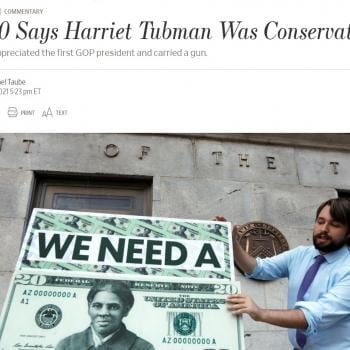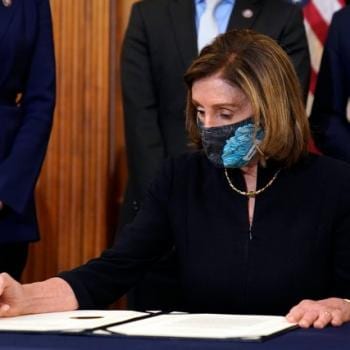A Guest Post by Rachel Lazerus
In his opening argument against the UN Convention on the Rights of Persons with Disabilities, Farris asserted that the pro-treaty side was not doing its due diligence and had not thoroughly analyzed the full legal effect of the law. “We don’t hear citations to articles of the treaty,” he intoned. “We don’t hear consideration of the reports, the concluding observations, by the Committee on the Rights to Persons with Disability. We don’t hear the kind of legal analysis that would be appropriate for analyzing the legal impact of this treaty.” Consistent with this criticism, Farris cited two experts known to be sympathetic toward the treaty in order to support his legal analysis: Columbia University’s Louis Henkin, one of the most influential legal scholars in the realm of human rights and international law, and University of London’s Geraldine Van Bueren, a leading human rights expert.
If you read my previous post on Michael Farris’s testimony before the Senate Foreign Relations Committee—and you should—you will know that prominent homeschool advocate Michael Farris is arguably the holdup to the Senate signing the UN Convention on the Rights of Persons with Disabilities (CRPD). Last week he testified before the Senate Foreign Relations Committee, arguing that the Senate should not ratify the treaty because doing so would limit parents’ rights to make decisions for their children and ultimately have a negative effect on homeschooling—even though Farris is essentially the only one to interpret the treaty in this way. When the Senate signs a treaty, it often also has to pass new laws for implementation, which will put the treaty into effect. This is not the case with the CRPD, because the CRPD itself is based on the Americans with Disabilities Act, which is already a part of U.S. law.
Farris denies that this is the case: he believes that ratifying the CRPD will inexorably lead to changes in US law. During his testimony, he cited references to Henkin and Van Bueren, whose arguments he claims the Senators have neither read nor even considered. But the problem here is not the Senate: it’s Farris.
Out of my desire to understand his reasoning, I looked up Farris’s citations and read them in their original context. What I found was stunning: the simple reality is that Farris took both Henkin’s and Van Bueren’s statements out of context and misapplied them to his own twisted legal theory. By citing each quote out of context, Farris was able to, as Senator Menendez said, take “a noncontroversial statement and twist it into something that’s rather sinister.” The very basis of Farris’s protestations against the CRPD, then, is a lie.
The Henkin Citation
 In his opening statement, Farris quoted this line by Louis Henkin:
In his opening statement, Farris quoted this line by Louis Henkin:
[…] the United States apparently seeks to ensure that its adherence to convention will not change or require change in US laws, policies, or practices, even when they fall below international standards. […] Reservations designed to reject any obligation to rise above existing law and practice are of dubious propriety: if states generally entered such reservations, the convention would be futile. […] Even friends of the United States have objected to its reservations that are incompatible with that object and purpose and are therefore invalid. The United States, it is said, seeks to sit in judgment on others but will not submit its human rights behavior to international judgment. To many the attitude reflected in such reservations is offensive. The conventions are only for other states, not for the United States.
Note the bracketed ellipses. For those readers unfamiliar with academic conventions, an ellipsis is used to indicate that text has been left out of a longer text. This is why a movie critic can write a review saying “this movie was no fun or good, you should stay home and spend the money for your family’s tickets on a new couch” and the movie producers can run an ad saying the critic said “fun…good…for your family”. Ellipses can disguise or hide what someone really said. Always take note when you see lots of ellipses.
Farris’s usage here was less egregious than the hypothetical movie producer’s ad, but did leave out important context. The full context of what Henkin said is found in an article he authored titled “U.S. Ratification of Human Rights Conventions: The Ghost of Senator Bricker,” published in The American Journal of International Law, Vol. 89, No. 2 (Apr., 1995), pp. 341-350. If you have access to JSTOR, you can read it here. The words Farris left out are in bold.
By its reservations, the United States apparently seeks to assure that its adherence to a convention will not change, or require change, in U.S. laws, policies or practices, even where they fall below international standards. For example, in ratifying the International Covenant on Civil and Political Rights, the United States refused to accept a provision prohibiting capital punishment for crimes committed by persons under eighteen years of age. In ratifying the Torture Convention, the United States, in effect, reserved the right to inflict inhuman or degrading treatment (when it is not punishment for crime), and criminal punishment when it is inhuman and degrading (but not “cruel and unusual”).
You can see why Henkin—again, a leading human rights lawyer—would be rather appalled at the US ducking such a provision, which is indeed contrary to the “object and purpose” of the treaty. (Indeed, the Supreme Court later prohibited capital punishment for persons under the age of eighteen in 2005’s Roper v. Simmons.)
Farris admitted that while the context was different, Henkin’s “principle was applicable” to the treaty at stake. This is denying a rather major contextual change. The main difference between Henkin’s argument in 1995 and Farris’s argument in 2013 is that when ratifying the International Covenant on Civil and Political Rights (ICCPR), the United States used a reservation in order to create a loophole, thus allowing the US to continue to execute juveniles under the age of 18 who were convicted of capital crimes. There is no such similar loophole being created by any proposed reservations to the Convention on the Rights of Persons with Disabilities (CRPD). Farris may genuinely believe that the reservations create such a loophole, but Farris also has a rather idiosyncratic view of both the phrase “the best interests of the child” and the purpose of the UN that is not reflected in mainstream thought and would not be supported by Henkin.
Furthermore, the issue remains: why cite Henkin? Henkin’s legal opinion is that the US should ratify treaties with fewer reservations in order to increase accountability to other UN member nations and that the US should enact legislation that would bring it to the same human rights standard as other foreign nations. Farris, who wishes to “enact an amendment to the Constitution so the demogogues [sic] in Washington DC can never again subject this nation to the duty to follow the law of the United Nations”, clearly does not wish to cede any type of sovereignty or oversight to the UN. He certainly would not want the US to follow the same kind of homeschooling laws currently practiced by Germany. It is very strange that Farris would be citing Henkin’s views on this one particular issue even as he admits that he disagrees with the substance of Henkin’s views, as well as with the conclusions that Henkin draws: Henkin thought that the US should stop using RUDs to duck responsibilities to foreign nations, while Farris would apparently prefer that the US stop signing treaties altogether.
(Perhaps Farris is regularly sloppy, or perhaps he’s just not very good with details, but it’s interesting to note that not only did Farris misspell Henkin’s name twice in his written brief, he also continually referred to Henkin in the present tense during his testimony. He did not seem to realize that Professor Henkin had passed away in October 2010. In contrast, Senator Menendez properly referred to Henkin using the past tense, and noted that not only would Henkin be in favor of the treaty, the human rights institutions that Henkin had founded and participated in also support ratification of the treaty.)
The Van Bueren Citation
 I earlier mentioned Farris’s idiosyncratic views on the phrase “the best interests of the child.” It’s certainly one he uses often; he referred to it six times during his testimony. In Farris’s view, this phrase is the smoking gun that reveals the perfidious nature of the UN treaty and its sinister aim to steal children from their parents’ authority and place them under the government’s control. His citation for this claim is always the same quote from Geraldine Van Bueren, which he cites as “Geraldine Van Bueren, International Rights of the Child, Section D University of London, 46 (2006).
I earlier mentioned Farris’s idiosyncratic views on the phrase “the best interests of the child.” It’s certainly one he uses often; he referred to it six times during his testimony. In Farris’s view, this phrase is the smoking gun that reveals the perfidious nature of the UN treaty and its sinister aim to steal children from their parents’ authority and place them under the government’s control. His citation for this claim is always the same quote from Geraldine Van Bueren, which he cites as “Geraldine Van Bueren, International Rights of the Child, Section D University of London, 46 (2006).
Best interests provides decision and policy makers with the authority to substitute their own decisions for either the child’s or the parents’, providing it is based on considerations of the best interests of the child.
This is clearly a passage that has imprinted on Farris’s brain, as he cites this exact quote in eight different documents on ParentalRights.org (in addition to citing various other quotes from different sections of the same document of Van Bueren’s). Like the previous quote from Henkin, it is incomplete and taken out of context.
I found a more complete version of Van Bueren’s quote in her 1995 work, “The International Law on the Rights of the Child,” on page 45—46, in a section called “The New Principles of Intervention.” The fuller context of the quote, which I located, makes it clear that Van Bueren is providing a historical overview of the way that the best interests standard has been applied, rather than stating the definitive legal view of the position.
Although the best interest of the child is common in domestic legislation it is not expressedly incorporated into many major human rights instruments. So, for example, neither the European Convention on Human Rights nor the International Covenant on Civil and Political Rights includes any such reference. This is partly because the rights approach of human rights treaties is at odds with the traditional welfare approach of best interests which undermines the child’s autonomy. Therefore, the inclusion of best interests of the child in a rights treaty, the Convention on the Rights of the Child, suggests that this traditional concept has been remoulded. In its broadest application the principle is articulated in article 3(1) of the Convention, which provides that, “In all actions concerning children whether undertaken by public or private social welfare institutions, courts of law, administrative authorities or legislative bodies the best interests of the child shall be a primary consideration.” [ . . . ]
As has been frequently observed, although the question is viewed from the child’s best interests, the answer is frequently given from an adult perspective. Best interests provides decision and policy makers with the authority to substitute their own decisions’ for either the child’s or the parents’, providing it is based on considerations of the best interests of the child, Thus the Convention challenges the concept that family life is always in the best interests of children and that parents are always capable of deciding what is in the best interests of children.
Farris may not agree with this expanded version any more than he agrees with the limited quote he has been using, but by placing Van Bueren’s quote in context, it’s clear that she is discussing the way that one specific convention—the UN Convention on the Rights of the Child (CRC)—uses the phrase “the best interests of the child”. And in fact, an unbiased look at the full context of Van Bueren’s work would show that, far from Farris’s view of a static and nefarious concept, Van Bueren argues that the phrase “best interests of the child” is not a “legal term of art” but rather an evolving legal concept that has been interpreted differently over time by various conventions on human and child rights.
(Since Farris also opposes the ratification of the CRC, it is worth including a short parenthetical on that treaty. Contrary to Farris’s assertions on the subject, the CRC actually supports the child’s right to be raised by his or her parents and includes numerous other provisions on the importance of parental involvement and decision-making in children’s upbringing. Yes, the CRC challenges the idea that parents always know what is best for their children—and the existence of abusive and neglectful parents suggests that this idea very much needs to be challenged—but it does not in fact make children wards of the state as Farris would have his followers think. For more, see this fact sheet published by UNICEF.)
The attentive reader will wonder why I am using a different text than Farris did for this quote. The answer is quite simple: the book that Farris cites does not exist. Van Bueren has never published a book called “International Rights of the Child”, nor does she list any books published during the year 2006. Searching for the same citation that Farris used in his written testimony only turns up documents on his website ParentalRights.org, or articles referring positively to Farris and his views. Indeed, I may be the first person ever to check Farris’s citation for accuracy.
I suspect, though I cannot outright prove, that instead of citing Van Bueren’s work directly, Farris is citing a study guide from a class he took for his distance-learning LLM.
The circumstantial evidence for this conclusion is very great. The program that Michael Farris was likely enrolled in can be found here, and it advertises as a selling point that the programs “have been developed by academics within Queen Mary and UCL Law departments.” Van Bueren is a professor at Queen Mary College at the University of London, and a course called “International Rights of the Child” is listed in the course catalogue for the distance-learning LLM (page 40). The required text for the class is a book written by Van Bueren. The class is broken down into four sections labeled A, B, C, and D, which matches the citations Farris uses throughout ParentalRights.org. While I was not able to locate the study guide for Section D, I did find a study guide for Section C, which seems to be a summary of Van Bueren’s earlier work. It appears that Van Bueren took part in preparing or at least approved the adaptation of her previous work into modules for the course offered by the University of London, which would explain why an identical sentence shows up in two works dated 11 years apart.
I have reached out to Michael Farris on his Facebook page and asked if he could clarify his sourcing for the Van Bueren quote. He has not yet responded to me, though he has posted several links since I asked. I would welcome any clarifications he can provide, and I’m sure Libby Anne would give him space to reply to this and the other questions I’ve raised.
It is not clear to me that Farris is deliberately twisting the context of Van Bueren’s quote, at least not in the same way that he knowingly used Henkin’s quote to apply to a different situation than the one Henkin intended. It is entirely possible that Michael Farris, while doing the required coursework for his online LLM degree from the University of London, stumbled upon the truncated quote he cites so regularly in his articles. If the quote appeared on its own when placed in the study guide, he may not have realized the greater context of the quote, and thus may have interpreted it as a prescriptive guide for using the phrase “best interests of the child”, and not as a descriptive definition given at one point in time, by one particular convention on children’s rights. If this is so, then Farris, like many graduate students before and after him, simply skipped doing the further required reading. In this scenario, he is guilty of doing only the bare minimum reading in order to graduate, rather than being guilty of the odiousness of deliberately and repeatedly twisting the context of the quote in order to further his own agenda.
Or, as he did to Henkin, he understood the context of Van Bueren’s quote, but deliberately took her words out of their original context in order to mislead others.
In both cases, he has committed the very great sin of improperly citing an unpublished study guide or course module as though it were a published book, incidentally making it very difficult for anyone to find the original citation. It’s almost like Farris felt he had something to hide.
And while it is a great rhetorical device to cite the direct and unvarnished words of your opponent—the observant reader will note my fondness for the tactic—it works best when you understand your opponents’ arguments. Farris does not understand Van Bueren’s text, and is willfully misapplying Henkin’s argument. His appeals to authority and expertise are thus invalid.
Conclusion
Now let’s return to Farris’s testimony last week. Farris said on his facebook page afterwards that giving his testimony to the Senate “wasn’t really any fun.” I must admit, tearing apart Michael Farris’s flimsy excuses for a legal argument has been great fun for me, though I do worry it is unsporting to be fighting a battle of wits with someone who shows every indication of having arrived unarmed.
Here’s the real problem, though. For all my snark here? Farris has won. And he is continuing to win.
Farris may have made himself look silly in front of the Senate, but he has shifted the Overton Window of homeschooling policy. We are unable to talk about ratifying a treaty on the disabled—a treaty which we are already following all of the requirements of—without multiple reassurances that homeschooling will remain unrestricted. These are completely unrelated topics and they should never have been conflated in the first place. The only reason we are talking about them together now is because of the twisted and outright false legal reasoning of a man who cannot string a sentence together about why homeschooling and disability are being discussed together without resorting to fallacies, and a man who hours afterwards is already trumpeting how persecuted he was. He cannot tell the truth about an event, even when the Senate session is broadcast, thus recording his every word.
On his Facebook page, Farris posted the following:
The shots were cheap and it wasn’t really any fun.
But here is the point. When the left stoops to these kinds of tactics, it is a sign of two things:
1. They have no effective answers to the substance of my arguments.
2. I am having an impact.
I hope that these blog posts have demonstrated to you that there are indeed very effective arguments for Farris’s arguments, and that Senators Boxer, Durbin, and Menendez used them well during the committee hearing. But I cannot deny the truth of Farris’s second assertion. He is having an impact. He has an agenda. And he has been using the members of HSLDA to implement that agenda.
It is long past time to take control away.
In the same Facebook post I cited above, Farris claimed that “the left” is targeting certain Republican senators who have previously voted against the treaty and asking them to change their vote. It’s now long past time for the left—and the center, and the right—to do just that. On PBS’s Newshour, Senator Menendez said that he counts 61 votes affirmed for the treaty, including Democrats, Republican, and Independents. For the Senate to pass the treaty, he needs 67. You can—and should—get involved. It’s as simple as picking up your cell phone.
To quote Farris himself in a fashion he may agree with, “If we let [Farris] get away with these tactics—our movement, indeed our country is doomed.” Truer words.
Call Your Senators!
If you live in one of these states, please call your senator and ask them to ratify the Convention on the Rights of Persons with Disabilities (CRPD). As long as the US refuses to ratify the CRPD, we look silly and backward and provide other nations with an excuse for refusing to sign the treaty or refusing to implement it. We need to lead by example, and ratifying the UN Convention on the Rights of Persons with Disabilities is part of setting that example.
HSLDA has helpfully provided an app on their website which will provide you with contact information for each of your representatives in Congress. I use it here as a wonderful information source, and I express my sincerest thanks to the good folks at HSLDA who make participatory democracy possible.
Sen. Bob Corker (TN) – (202) 224-3344
Sen. Thad Cochran (MS) – (202) 224-5054
Sen. Rob Portman (OH) – (202) 224-3353
Sen. Tom Coburn (OK) – (202) 224-5754
Sen. Jeff Flake (AZ) – (202) 224-4521
Sen. Johnny Isakson (GA) – (202) 224-3643
Sen. Saxby Chambliss (GA) – (202) 224-3521
Sen. Debra Fischer (NE) – (202) 224-6551
Sen. Ron Johnson (WI) – (202) 224-5323
Sen. Michael Johanns (NE) – (202) 224-4224
Sen. Roy Blunt (MO) – (202) 224-5721
Sen. Lamar Alexander (TN) – (202) 224-4944
Sen. Dan Coats (IN) – (202) 224-5623
Sen. John Boozman (AR) – (202) 224-4843
And if you appreciate the effort Senators Boxer, Durbin, and Menendez put into dismantling the arguments of Farris, call them and tell them so.
Sen. Barbara Boxer (CA) – (202) 224-3553
Sen. Dick Durbin (IL) – (202) 224-2152
Sen. Bob Menendez (NJ) – (202) 224-4744
Let’s get involved and get this treaty ratified.
—————
Rachel Lazerus received her MPP from the Harris School of Public Policy at the University of Chicago in 2012. She is currently researching comparative methods of reporting homeschooling achievement.















